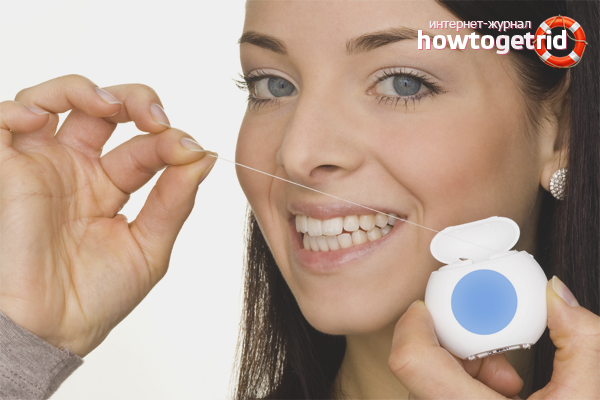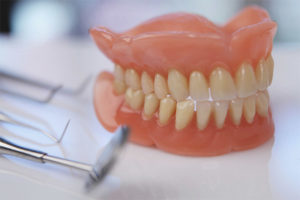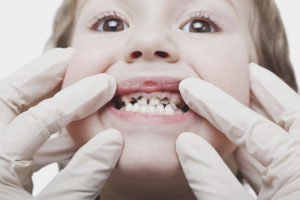The content of the article
Moms teach us to brush our teeth in the morning from early childhood, but not everyone is engaged in oral hygiene even before bedtime, what can we say about the use of dental floss. It’s much more convenient to take a toothpick and, after each meal, try to clean your teeth with it. Aesthetics and a culture of health is made up of many little things. Dental flosses, the so-called flosses, are becoming increasingly popular among people trying to minimize dental problems.
What is dental floss for?
Do not just think that you can take a piece of ordinary thread for sewing as dental floss. Modern science does not stand still, one of its latest inventions is dental floss, which is called floss and is intended for hygiene of molars. It is she who will help get rid of the main pathology - caries, which affects more than half of adults and many children.
With a toothbrush, you can only clean the external surfaces of the tooth, but getting to the interdental area is beyond her power. The teeth are in close contact with each other, so no bristles, no matter how thin they are, can thoroughly clean and rid of food debris from the internal contact surfaces. And the food that lingers between the teeth, not only creates an unpleasant odor in the mouth, but also, decaying, forms an excellent environment for harmful microorganisms.
Types of Dental Flosses
Dental floss has many varieties, each person can choose the most suitable option, it all depends on the width of the distance between the teeth, the presence of prostheses, tactile sensations and just personal preferences. Prevention of caries does not depend on which thread you use, the main thing is to use it. How are the flosses divided?
- Dental flosses are round, they are intended for those with wide gaps between the teeth, or flat, for people with very close contact of adjacent teeth.
- The impregnating composition of the thread may contain therapeutic or prophylactic substances - fluoride or chlorhexidine. Sometimes components that create a pleasant aroma are added to give the cleaning procedure aesthetic pleasure.
- Flosses are waxed and not waxed. The first ones are smoother, easier to slide between the teeth, acceptable for beginners to gradually learn how to use the threads without damaging the gums. Not waxed intensively clean the spaces between the teeth and more effectively eliminate plaque and harmful bacteria. Gradually, you need to move from waxed to such threads.
- Natural silk or synthetic fibers such as nylon or teflon are used as the main material for dental floss. Everything natural is better, but silk thread wears out and breaks faster. Synthetic threads are more expensive, but they last longer. The most popular are nylon flosses, due to the price - quality ratio.
How often to use dental floss
Dental floss can be used as needed, however, experts advise daily prophylactic use of floss at bedtime or at least twice a week. Only with its help you can effectively get rid of plaque.
Opinions differ on what to do first, brushing your teeth, and then floss, or vice versa. Some people think that floss can bring bacteria under the gums, while others think that it is easier to carry out final dental hygiene after flossing. All agree on one thing - the use of flosses is very useful.
Remember! Before using dental floss, be sure to wash your hands. Do not buy your own floss without consulting a dentist, especially if you have braces or dentures.
How to use dental floss
To effectively clean teeth from plaque and prevent germs from getting under the gums, it is necessary to use dental floss correctly. Check out important guidelines to help you avoid tooth decay and periodontal disease. Follow the procedures in the following order:
- Prepare 40-50 cm of floss, unwinding the necessary length from the spool, wind the thread around the middle fingers so that between them 5-10 cm of thread are formed, with which you will brush your teeth.
- Holding the dental floss firmly with the thumb and forefinger of your hand, carefully draw it up and down between the two teeth, repeating these movements several times. Gradually move from one tooth to another, while moving the thread to a clean area.
- Then, you can wrap the thread around the base of one tooth so that it goes slightly under the gum. While cleaning the tooth, you can perform circular movements. In no case do not make sharp efforts, otherwise you may injure the soft tissue of the gums. Here you need a special accuracy and leisurely.
- Remember that for each new tooth you need to use clean areas of the floss, otherwise you will spread bacteria between healthy and not very clean teeth.
- To remove dental floss from the space between the teeth you need smooth movements forward, backward. Naturally, you can’t do without a mirror at first.
- Do not worry that you will not be able to learn how to apply floss, just start and you will quickly get used to it. Further procedures will be performed automatically.
- Never use a used thread a second time, otherwise the entire process of purification completely loses its meaning.
- At the end of using the floss, it would be nice to brush your teeth with a toothbrush, you can connect an additional mouthwash for additional disinfection.
Contraindications for flossing
Some medical observations show that sometimes improper flossing can lead to inflammatory diseases of the oral cavity, and sometimes unexpected tooth loss. All this happens for one reason only - non-compliance with flossing technique. Constant touching of the gums with a thread leads to the fact that they become sensitive, soft tissue is broken, then infections easily penetrate into the accessible environment.
Carefully ensure that the gums do not bleed after using dental floss, this may be a consequence of periodontal disease. In this case, you should immediately contact your dentist. The use of flosses is also not recommended for large carious disorders, with the appearance of cavities. In such a situation, the thread can only aggravate the picture, causing additional damage.
Flossing is not recommended for young children under ten years of age, and after this age, this procedure can only be performed under adult supervision.
If you understand everything perfectly, do not wait and do not hesitate, take care of the condition of your teeth. The procedure for cleansing with dental floss is not complicated and quite effective. After all, a snow-white smile is not only an element of a charming image, but also an indicator of good human health.
Video: how to use dental floss











Submit